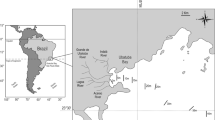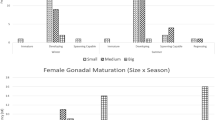Abstract
Sex-related rostral variability was studied in the aristeid shrimp Aristeus antennatusfrom the Eastern Ionian Sea (Mediterranean). Shrimps were collected on a monthly basis from December 1996 to November 1997 using a commercial bottom trawl in a depth range of 446–728 m. Female relative growth of rostrum proved to be negative allometric both seasonally and in the pooled annual data set. Males on the other hand, showed no or negative correlation of rostrum length with size. Mature males with short rostra dominated in the male population all year around. The appearance of males with long and intermediate rostra during winter, which disappear thereafter in favour of those with short rostra, indicates that rostrum shortening takes place during the end of winter. The increase of mated females during spring supports the hypothesis already addressed by other authors on the function of the male short rostrum in this species mating behaviour. Nevertheless, the paucity, in comparison to other Mediterranean populations, of males with long or intermediate rostra could indicate that for the bulk of the male population, the process of rostrum shortening in the Eastern Ionian Sea occurs outside the geographical locality or depth range sampled.
Similar content being viewed by others
References
Bas, C. & F. Sardà, 1998. Long-term morphometric variations in a population of the deep-sea shrimp Aristeus antennatus (Risso, 1816) (Decapoda, Aristeidae). Crustaceana 71(4): 369–377.
Bianchini, M. L. & S. Ragonese, 1994. Life Cycles and Fisheries of the Deep-water Red Shrimps Aristaeomorpha foliacea and Aristeus antennatus. Proc. of the International Workshop held in the Instituto di Tecnologia della Pesca e del Pescato, N.T.R.-I.T.P.P.: 87 pp.
Bliss, D. E., 1982. Shrimps, lobsters and crabs. New Century Publishers, Inc., Piscataway, New Jersey.
Burukovsky, R. N., 1972. On the function of the rostrum in shrimps. Trudy Atlanticheskii Nauchna-issledovatel'skii Inst. Rybnogo Kozyaistva I Okeanografii (AtantNIRO) 42: 176–179 (in Russian).
Burukovsky, R. N. & L. L. Romensky, 1972. On the variability of the rostrum in the Aristeus varidens (Decapoda, Penaeidae). Trudy Atlanticheskii Nauchna-issledovatel'skii Inst. Rybnogo Kozyaistva I Okeanografii (AtantNIRO) 42: 156–161 (in Russian).
Carbonell, A.,M. Carbonell, M. Demestre, A. Grau & S. Monserrat, 1999. The red shrimp Aristeus antennatus (Risso, 1816) fishery and biology in the Balearic Islands, Western Mediterranean. Fish. Res.44: 1–13.
Cartes, J. E. & F. Sardà, 1989. Feeding ecology of the deepwater aristeid crustacean Aristeus antennatus (Risso, 1816) in the Mediterranean Sea. Mar. Ecol. Prog. Ser. 54: 229–238.
Demestre, M. & J. M. Fortuño, 1992. Reproduction of deep-water shrimp Aristeus antennatus (Decapoda: Dendrobranchiata). Mar. Ecol. Prog. Ser. 84: 41–51.
D'Onghia, G. & P. Maiorano, 1996. Variabilitá della lunghezza del rostro nei maschi di Aristeus antennatus (Risso, 1816). Bio. Mar. Medit. 3(1): 147–149.
Kapiris, K., M. Thessalou-Legaki, M. Moraitou-Apostolopoulou, G. Petrakis & C. Papaconstantinou, 2000. Population charac-teristics and feeding parameters of Aristaeomorpha foliacea and Aristeus antennatus (Decapoda: Aristeidae) from the Ionian Sea (Eastern Mediterranean). In Von Vaupel Klein, J. C. & F. R. Schram (eds), The Biodiversity Crisis and Crustacea. Crustacean Issues 12: 177–191.
Matarrese, A., G. D' Onghia, A. Tursi & M. Panza, 1994. Experimental catches of Aristeus antennatus and Aristaeomorpha foliacea in the Ionian Sea. In Bianchini M. L. & S. Ragonese (eds), Life Cycles and Fisheries of the Deep-water Red Shrimps Aristaeomorpha foliacea and Aristeus antennatus. Proc. of the International Workshop held in the Instituto di Tecnologia della Pesca e del Pescato, N.T.R.-I.T.P.P.: 57–58.
Mura, M. & A. Cau, 1989. Sul dimorfismo sessuale e sex-ratio in Aristeus antennatus (Risso, 1816). Oebalia 15(2), N. S.: 811–814.
Mura, M., S. Campisi & A. Cau, 1992. Osservazioni sulla biologia riproduttiva negli aristeidi demersali del Mediterraneo Centro-Occidentale. Oebalia, suppl.17: 75–80.
NCMR, 1999. Developing deep-water fisheries: data for their assessment and for understanding their interaction with and impact on a fragile environment. EC FAIR PROJECT CT 95-0655, Final Report: 144 pp.
Palombi, A., 1939. Note biologiche sui Peneidi. La fecondazione e la deposizione delle uova in Eusicyonia carinata (Olivi). Boll. Zool. 10: 223–227.
Relini, L. & L. Tunesi, 1987. The structure of the spermatophore in Aristeus antennatus (Risso, 1816). Inv. Pesq. 51(supl. 1): 461–470.
Sardà, F. & A. Gordoa, 1986. Different aspects about capture and sampling of Aristeus antennatus (Risso, 1816) (Decapoda, Penaeidae). Cons. Perm. Int. Expl.Mer, C.M./ICES K/40: 12 pp.
Sardà, F. & M. Demestre, 1987. Estudio biologico de la gamba Aristeus antennatus en el Mar Catalan (NE de Espana). Inv. Pesq. 51(suppl. 1): 213–232.
Sardà, F. & M. Demestre, 1989. Shortening of the rostrum and rostral variability in Aristeus antennatus (Risso, 1816) (Decapoda, Aristeidae). J. Crust. Biol. 9: 570–577.
Sardà, F., C. Bas & J. Lleonart, 1995. Functional morphometry of Aristeus antennatus (Risso, 1816) (Decapoda, Aristeidae). Crustaceana 68: 461–471.
Sardà, F., C. Bas, M. I. Roldán, C. Pla & J. Lleonart, 1998. Enzymatic and morphometric analyses in mediterranean populations of the rose shrimp, Aristeus antennatus. J. exp. mar. Biol. Ecol. 221: 131–144.
Teissier, G., 1960. Relative growth. In Waterman, T. H. (ed.), The Physiology of Crustacea, Vol. 2. Metabolism and growth: 537–560.
Thessalou-Legaki, M., 1994. Distribution of Aristeus antennatus and Aristaeomorpha foliacea in the Eastern Mediterraneaen Sea. In Bianchini, M. L. & S. Ragonese (eds), Life Cycles and Fisheries of the Deep-water Red Shrimps Aristaeomorpha foliacea and Aristeus antennatus. Proc. of the International Workshop held in the Instituto di Tecnologia della Pesca e del Pescato, N.T.R.-I.T.P.P.: 61–62.
Author information
Authors and Affiliations
Rights and permissions
About this article
Cite this article
Kapiris, K., Thessalou-Legaki, M. Sex-related variability of rostrum morphometry of Aristeus antennatus (Decapoda: Aristeidae) from the Ionian Sea (Eastern Mediterranean, Greece). Hydrobiologia 449, 123–130 (2001). https://doi.org/10.1023/A:1017549205275
Issue Date:
DOI: https://doi.org/10.1023/A:1017549205275




